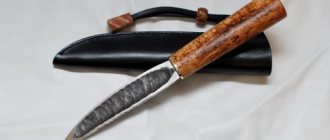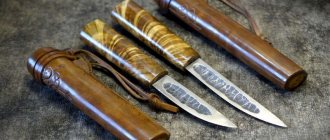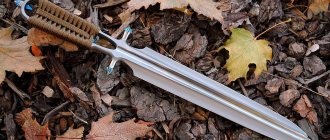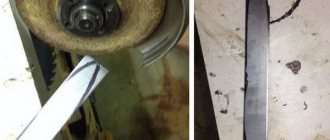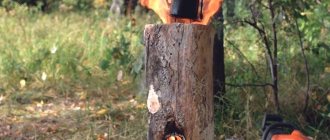What is a taiga ax
First, of course, we’ll talk about the forged taiga axes we made, and compare them with purchased carpenter’s axes. Then considerations on the recipes for making your own from ready-made axes, which are common on the Internet.
Purpose
A taiga ax is an ax that is convenient to use for hunting, long hikes and work in forest areas. It is intended for collecting firewood, setting up a camp, and, quite often, for cutting up the carcasses of large animals. Therefore, optimal blade hardness, a reliable ax handle, and a convenient case are required.
Buy a taiga ax or make it yourself?
Carpenter's axes are usually on mass sale, but they are not very convenient for working in the forest. A long time ago, skilled people lightened and modified purchased axes for camping use; now a whole industry has emerged for regrinding axes and turning them into “author’s” ones. If everything is done correctly: the shape, the attachment on the ax handle, heat treatment and sharpening, you can get a good tool. But we prefer axes that are completely hand forged and designed specifically for working in the forest. The advantages of such an ax: optimal shape, light weight, more durable blade due to free forging rather than stamping. Therefore, we will first show off our axes, and only at the end of the article will we tell you how to make a taiga ax with your own hands.
What is a taiga ax
The taiga ax is a tool used to work in the forest. It differs from ordinary models:
- optimal shape;
- low weight;
- forged durable blade.
Taiga axe.
If desired, you can make the device yourself. In the process changes:
- form;
- sharpening;
- attachment on the ax handle.
Features of the taiga ax
The product is different:
- with a long ax - this provides a better swing when striking. It reaches a length of 50 cm or more. This does not affect the weight, the entire mass is concentrated in the metal head;
- there is no upper part of the blade in the head. When remodeling from a carpenter's version, this part is sawed off;
- The blade has a rounded shape rather than a straight one. Thus, the product replaces the cleaver;
- a hammer can be replaced with a butt;
- using an eye and a wooden wedge, securely fix the head to the ax handle;
- a head angle of less than 65 degrees prevents your hands from getting tired quickly;
- a beard that connects the head to the ax handle and prevents breakage of the wooden part. Absorption capacity 60% strength;
- a fungus whose purpose is safe.
Being in various difficult terrain, it is possible to:
- tree cutting, firewood harvesting, sanitary felling;
- working with large logs, removing knots, removing thick bark, making grooves;
- rescue from attacks by wild animals by promptly creating traps;
- construction of a hut or hut 4 times faster than with other devices.
Perfect fit:
- hunters; Forest axe.
- tourists;
- fishermen;
- foresters;
- geologists.
Purpose
Item used:
- on a hike;
- on the hunt;
- for working in difficult to pass places.
With it you can:
- prepare firewood;
- set up a camp;
- cut up animal carcasses.
All this is possible thanks to the hardness of the blade, a reliable ax handle and a convenient case.
Taiga ax shape
Blade thickness
The thickness of the blade of a carpenter's axe. (in the photo “WORK - VACHA” Tiger).
The main difference between a taiga ax and a carpenter's ax is the thickness of the blade. A carpenter's ax has a thin blade. This allows you to work at an acute angle to the wood, carefully trim, removing thin chips and obtaining a flat surface. If you hit hard with such an ax along the fibers (trying to split a more or less thick log), the ax will get stuck with each blow, so the farm uses a cleaver to split logs separately, and to roughly split long logs into blocks, a heavy axe, a wedge and a sledgehammer.
Blade thickness of a taiga ax
The taiga ax has a wedge-shaped profile, which provides the following advantages:
- With a strong blow diagonally across the grain, the ax cuts deeply and breaks off the chips rather than getting stuck in the wood.
- The ax can be used when splitting along the grain; it effectively splits the log and does not get stuck at all.
You can watch the taiga ax in action in the video.
Video of working with a taiga ax
Sometimes it is necessary to cut logs onto blocks when setting up a camp or to split large logs into logs. Our ax, thanks to its wedge-shaped shape, almost never gets stuck, even when driven deep into a tree along the grain; in addition, it is easy to pull it out of the log. Anyone who has tried to chop thick and knotty logs with a regular ax knows how difficult it is to pull out a stuck carpenter's axe. Carrying a separate heavy splitting cleaver or a wedge and a sledgehammer in the forest is inconvenient and often simply impossible.
Shape and size of working edge
Pine 35cm thick. Pay attention to the size of the chips and the cut.
The taiga ax has a large semicircular blade, which makes it possible to penetrate the wood as much as possible with a strong blow. The maximum blade size with low weight is ensured by the beard-shaped shape, which has traditionally been used for all forest axes since ancient times. In addition to the efficient transfer of impact energy, the large size also increases operational safety. It is more difficult to miss when cutting down a branch or chopping in an inconvenient place with an ax with a large blade.
Bearded ax shape
Another important difference is the beard-like shape, which is most noticeable. When trying to make a taiga ax from a carpenter's one, they often start by cutting out part of the blade. Advantages of a beard shape
- The beard-shaped shape of the ax allows you to significantly reduce the weight of the ax while maintaining a large blade length, but reducing weight without losing strength is possible only when using free forging.
- The ax gets stuck less when cutting wood.
- The lower part of the blade is a reliable protection for the upper part of the ax from damage in case of an accidental miss.
Features of the taiga ax
A sharp chopping tool is indispensable on a hike or on a picnic for rough work with trees and logs (Figure 1).
For these purposes, an ordinary cleaver is often used; the taiga ax has wider applications:
- In the manufacture of hunting wooden traps, for the installation of huts and the construction of basic means for crossing water bodies.
- Cutting and harvesting animal carcasses as a means of self-defense when attacked by wild animals.
- In addition to cutting firewood and trees, it can be used to remove bark from logs, cut off twigs and branches, and split wood along the grain.
What makes the tool so versatile is the correct shape of the taiga ax; unlike a carpenter’s axe, it has a number of characteristic features:
- A long handle allows you to make a wide swing, increasing the force of the blow.
- Less weight due to the cutting of the upper toe, which strengthens the structure during operation at low temperatures.
- There is no upper part on the head blade - it is equipped with a beard for greater strength of the product.
- A hardened butt with a thickness of 15-17 mm, ensuring high strength of the head.
- Rounded blade for ease of use in a variety of forestry jobs.
Figure 1. The taiga ax differs in many ways from a carpenter's tool.
The taiga tiger ax differs not only in its unusual geometry, but also in its special approach to its manufacture. The ax handle is fitted manually using wooden wedges and is not made on a machine. Hardening and forging are carried out using the technologies of old Russian gunsmiths, and the handle is made from high-quality varieties of birch. A protective leather case is included.
Balanced and thoughtful for solving many problems, the bear is a taiga ax with pronounced distinctive features.
Its heel is thinner than its nose and is suitable for planing, while its nose can easily split logs. The impact butt of the product lasts for many years and is specially heated, which provides it with high strength. With a short length, the main weight lies in the metal part - the head, which allows you to work for a long time with one hand, and it is easy to cut something with two hands.
An ax handle mounted with a reverse thrust for a taiga ax
The taiga ax requires an ax handle that is very different from a carpenter's axe.
Shape of the ax
The handle of a carpenter's axe, the so-called “Dutch” axe, is strongly curved and makes it possible to deliver precise and accurate blows.
For the taiga ax, a long, almost straight ax is used, which allows you to deliver very strong blows with both hands. Our ax handles are long, the length of the ax is 55-60cm, but, if desired, we can also use a shortened ax handle of 40-45cm. The shape is almost straight, but there are two small bends that allow you to conveniently intercept the ax handle with both hands for chopping from right to left and left to right, and also to hold the ax “under the neck” or, conversely, by the end of the ax handle - when you need to chop off a branch or twig. leaning over. Instead of a fungus, there is a small bend at the end of the ax that prevents the ax from slipping out of the hand. In general, the ax handle is comfortable and safe, allowing you to work in thick gloves in winter. The material is very durable Caucasian ash; we impregnate the ax handles with natural linseed oil for two weeks. The oil polymerizes on top and protects it from moisture, but inside the wood it remains liquid and can melt if you place the ax near the fire, even after a year (There is no need to specifically place the ax near the fire or on a radiator, although an ax with a reverse thrust is very easy to repair if it dries out) .
Reverse ax attachment
A carpenter's ax is mounted on a curved "Dutch" axe-handle with wedging, otherwise it is simply impossible. For fitting a forest ax, a reverse insertion is better than a direct insertion onto a wedge. Being in a damp forest, a dry city apartment, in the cold or near a fire will cause the wood to dry out and can lead to premature drying out of the ax. It is not difficult for a carpenter to repair an ax at any time, but in the forest it is better to have a more reliable tool. If an ax with a reverse thrust becomes dry, it is enough to simply knock it down with a strong blow to hard wood and continue working. Also, such an attachment is more reliable during heavy power work: the ax does not become loose, but only settles more tightly up the ax handle. Hammers, pickaxes, and cleavers are also mounted on the handle with a reverse thrust; in this way, ancient battle and lumberjack axes were mounted - all tools for which impact force and reliability are more important than high accuracy and accuracy.
Sharpening the taiga ax
For a carpenter's ax, the ability to carefully remove thin chips and accurately process the surface is important. Therefore, carpenter's axes are sharpened into a razor, the sharpening angle can be up to 25 degrees. There is always a block in the box with carpentry tools in order to quickly correct the sharpness of the sharpening. The master treats his tool with care, he is afraid not only of the blade getting into the ground, but also of working on wood contaminated with sand, which can damage the sharpening. For a taiga ax, accuracy of work is less important, but efficiency and reliability are important. To maintain the effectiveness of a sharpened ax, but to protect the working edge from accidental damage, a little trick is used: the main blade is forged and forms a single wedge with an angle of 12-15 degrees, and the working edge itself (the first 2-2.5 mm) is brought together at an angle of 30 -35 degrees. This sharpening gives maximum efficiency, but also protects the edge from random pebbles and sand, and does not allow the blade to quickly shrink when working on hard wood and bone.
Distinctive features of a hunting ax
This equipment tool, unlike an ordinary axe, is quite compact and ergonomic. At the same time, he can easily cut the bone of a large animal when cutting a carcass. The average length of an ax is 40 cm, and the weight does not exceed 750 g. However, depending on the brand and material, some models may have slightly different parameters. Basically, the tool is made of all metal, with soft rubber inserts on the sides.
Inserts minimize the possibility of the ax slipping from your hands and make all manipulations safer
Case for ax
To carry the axe, we made a comfortable case from durable genuine leather 3mm thick. The cover is stitched with double thread so that the sharpened ax blade cannot cut through the seam, and a gasket is made along the seam - the third layer of leather. The most critical places are reinforced with rivets.
Case features
- The case is made of durable leather and is completely closed. This is done so that the owner of the ax avoids injury if he falls on a sharpened ax fastened to his belt.
- The ax is hung on the waist belt with the butt forward with a slight tilt (like a saber). This placement prevents the ax, even with a long axe, from clinging and getting tangled in branches and touching your legs when walking. The ax does not interfere with climbing over forest rubble and squatting.
- The cover of the case closes with a holster clasp through a small strap. This design makes it possible to take out the ax and put it back in with one hand, even if you are wearing thick mittens.
A short summary of our taiga axes
If everything suits you, then you can choose and buy a forged ax in our catalog. Many people are interested in how to make a taiga ax with their own hands. We also sharpened, welded, forged and hardened industrial axes a lot, although the video has not been preserved from those long ago. Below is my experience, but other people's sound videos.
Review of popular models
Apart from the homemade axe, today's market offers a wide variety of models. We list only the most popular models:
"Trud Vacha" B-1 0.6 kg
The ax handle is made of hardened steel, tapeze-shaped, the handle is made of birch. Weight – 850 g, length – 35 cm.
"Izh" Tourist TT
The blade is made of hardened steel, with a figured cut, the handle is made of varnished wood. Weight – 880 g, length – 41 cm.
"Izh" AO-1.2 kg, hunting
The blade is made of hardened steel, with a projection, the handle is made of varnished wood. Weight – 1 kg, length – 49 cm.
"Matrix"
The blade is made of high-quality hardened steel, the non-slip handle is made entirely of fiberglass. Weight – 950 g, length – 37 cm.
Of course, this is not a complete list. Today on the market there are countless different models from different manufacturers, parameters and configurations, made from a wide variety of materials. In addition, many hunters with the appropriate skills prefer to make a hunting ax with their own hands, taking into account their own preferences, habits and characteristics.
Making a taiga ax with your own hands
There are quite a lot of videos on the Internet on remaking a purchased ax; sometimes you get very interesting examples that you want to share. Once upon a time we also customized purchased axes to suit ourselves; we will write about some of the nuances. For the most part, it comes down to cutting a unique shape from a carpenter’s axe. Often, authors also harden and fine-tune the sharpening of the ax; much attention is usually paid to finishing.
The production of a sharpened ax takes place in several stages:
- Choosing an ax . As a donor ax, they are trying to select an old ax made in the 1950s-70s; it is believed that at that time the steel was better; axes produced by ZIK, 1st GPP, which have the mark of military acceptance, are especially valued. Watch the video of testing the ax from Sokolov, it will become clear why he used the Bison ax as a donor, and not a carpenter’s one.
- Drawing of a taiga ax . In most cases, a full-size sketch is made on paper, which is then cut out and glued to the axe. You can also simply mark the markings with a marker or soft pencil directly on the axe.
- Making a taiga ax . Using an angle grinder (grinder), the excess is cut out and roughly shaped. Subsequently, finer processing and trimming of the cut line is carried out using a tool that is accessible and more convenient. This can be a grinder with a cutting disc and grinding attachments, if the shape leaves enough access to the area to be processed, and a grinder or grinder belt, in some places it can be processed with an electric sharpener. Finishing a complex shape often takes longer than just rough cutting with a grinder.
- Ax hardening. Domestic axes are made of U7 steel, less commonly U8.
The correct full cycle of heat treatment: annealing (heating to 740-760 with slow cooling to 550 degrees), hardening (heating to 800-830 degrees and quenching a three-centimeter cutting edge in water for a minute and a half) and tempering at a temperature of 270-320 degrees for an hour. Without a lot of experience (it is possible to determine the temperature by color with sufficient accuracy for such work) and equipment (a pyrometer or a muffle furnace with a precisely set temperature is desirable), it is difficult, but doable. If you do it for yourself, then after a few attempts you will get satisfactory hardness without brittleness. You can watch the video on how to harden an ax at home, without a pyrometer and a hardening furnace. A simpler option: water hardening from temperature insensitivity to a magnet and, of course, tempering for 1 hour at 300 degrees can give a good result. Only the blade needs to be hardened (immersed in water) - let the butt cool slowly in the air. It is important to check the hardening and make sure that the ax blade is not overheated.
